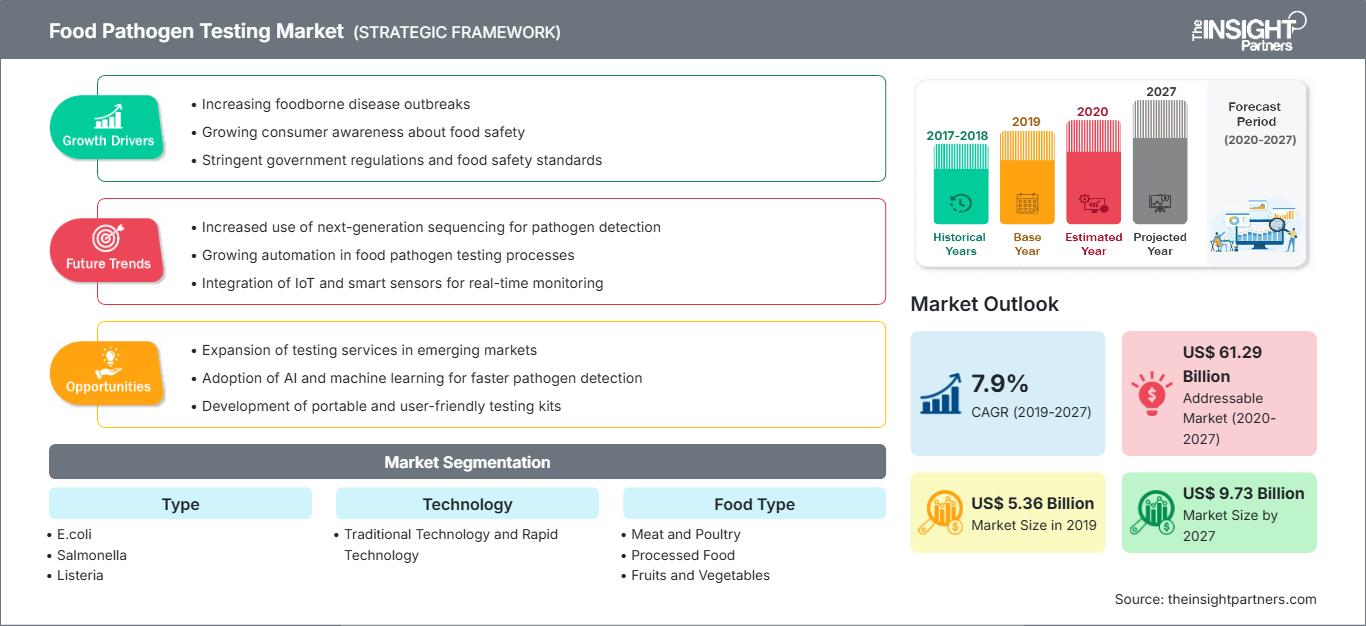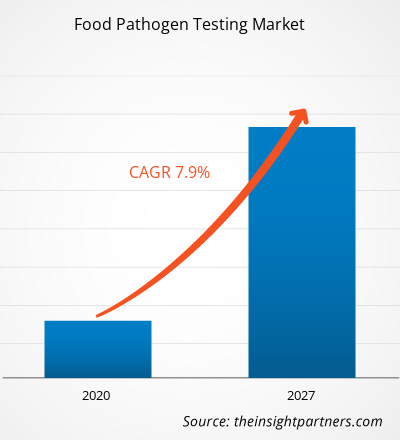2019 年,食品病原体检测市场规模为 53.6094 亿美元,预计到 2027 年将达到 97.3191 亿美元;预计 2020 年至 2027 年的复合年增长率为 7.9%。
食品病原体检测是指帮助监测食品中是否存在任何危及生命的细菌或微生物的过程。食品病原体检测对食品行业至关重要,因为已知的病毒和细菌约有 31 种,可导致有害的食源性疾病。这种检测方法应用于食品生产的每个环节,以确保食品安全。由于食物中毒案例增多,安全问题日益严重,相关法规也不断出台,这推动了食品病原体检测市场的增长。此外,聚合酶链式反应和免疫磁分离等各种食品病原体检测方法的进步以及检测时间的缩短,促使食品行业的各类参与者纷纷采用食品病原体检测。
预计在预测期内,欧洲的食品病原体检测市场将以最高的复合年增长率增长。该地区市场的增长主要归因于食源性疾病发病率的上升,以及人们对食品安全意识的不断提高,这推动了北美对食品病原体检测的需求。病原体检测方法的发展以及纳米生物技术也支持了市场的增长。医疗费用的增加以及转基因生物在食品和饮料行业的应用也刺激了市场的发展。食品贸易的全球化和经济发展促进了该地区食品病原体检测市场的扩张。食品消费者和制造商对食品病原体检测益处的认识不断提高,为食品病原体检测市场的发展提供了丰厚的机遇。
自定义此报告以满足您的要求
您将免费获得任何报告的定制,包括本报告的部分内容,或国家级分析、Excel 数据包,以及为初创企业和大学提供超值优惠和折扣
食品病原体检测市场: 战略洞察

-
获取本报告的主要市场趋势。这个免费样本将包括数据分析,从市场趋势到估计和预测。
由于封锁、旅行禁令和企业停工,COVID-19疫情对各国的经济和行业产生了不利影响。食品和饮料是遭受严重影响的重要行业之一,例如供应链受限和生产工厂停工。各国工厂的停工扰乱了全球供应链,并对制造活动、交货时间表和多种商品销售产生了负面影响。多家公司已经宣布产品交付可能出现延迟,未来产品销售也可能出现下滑。此外,欧洲、亚洲和北美国家实施的全球旅行禁令也阻碍了商业合作和伙伴关系机会。因此,这些因素制约了食品和饮料行业食品病原体检测市场的增长。
市场洞察:乳制品生产中快速病原体检测的增加有望推动食品病原体检测市场的增长
随着食品安全技术的发展,食品病原体检测技术也在不断改进和应用。如今,乳制品生产商可以选择多种方法进行准确、快速的病原体检测,这些方法适用于不同类别的产品、设施和工作流程。快速食品病原体检测技术基于不同的化学反应,目的是以最有效和最高效的方式检测目标病原体。基于酶联荧光分析 (ELFA) 的技术针对病原体上的特定细胞表面受体进行识别。基于聚合酶链式反应 (PCR) 的技术可以靶向每种病原体内部的 DNA。
在乳制品厂实施快速检测技术有很多优势,例如可以更快地获得结果,从而进一步提高检测效率,从而提高生产效率、减少产品保存时间并延长保质期。使用快速检测技术还有利于更快地响应不良事件,使乳制品生产设施能够实施任何必要的纠正措施,防止因浪费和腐败造成的损失。此外,这些快速食品病原体检测方法易于使用,并提高了人员的灵活性。大多数乳制品制造商都已实施内部检测计划。通过适当的培训和合适的仪器,高级微生物学学位不再是实施成功病原体检测计划的障碍。此外,快速检测方法的可及性和可负担性的提高,使乳制品制造商能够将数据保存在内部,增强了样品和结果的可追溯性和可控性。数据的利用和存储进一步帮助制造商运用分析技术,做出从供应链到生产线再到仓储设施的主动决策。由于快速病原体检测的优势,乳制品制造商在其生产部门实施该技术,从而促进了食品病原体检测市场的增长。
类型洞察
根据类型,食品病原体检测市场分为漂白和自然两种。沙门氏菌在 2018 年占据了较大的市场份额,预计在预测期内将实现更高的复合年增长率。沙门氏菌是最常见的影响人体肠道的细菌性疾病。它会导致腹泻、腹部绞痛和发烧。它主要是由于食用生的或未煮熟的肉类、家禽和蛋制品引起的。沙门氏菌感染会削弱免疫系统,尤其是在婴儿、妇女和成年人中。有时它会危及生命,因此食品病原体检测主要针对沙门氏菌。感染沙门氏菌的风险非常高,人们很容易被感染。因此,为了防止这种感染和人类生命的损失,食品病原体检测在这一领域发挥着非常重要的作用,这反过来又推动了食品病原体检测市场的增长。
食品类型洞察
根据食品类型,食品病原体检测市场细分为肉类和家禽、乳制品、加工食品、水果和蔬菜以及谷物和谷类。肉类和家禽在2018年占据了最大的市场份额。全球肉类消费量因其健康益处而大幅增长,例如蛋白质摄入量的增加以及户外聚餐支出的增加。由于消费者意识和健康意识的增强,对产品质量的改进或保持也起到了推动作用。由于家禽、肉类和海鲜产品中食品病原体爆发的增加,相关法规的制定也促进了该领域的增长。与肉类和家禽相关的最重要病原体是大肠杆菌、弯曲杆菌和沙门氏菌。剥皮和去毛过程中不卫生的条件和不当处理预计会导致污染,从而支持这一细分市场的增长。
技术洞察
根据技术,食品病原体检测市场分为传统技术和快速技术。快速技术在2018年占据了最大的市场份额。传统技术简单的步骤和较低的初始成本支撑了该细分市场的增长。它具有多种优势,例如降低成本和提高准确性,这些优势可能会推动这一细分市场的增长。尽管传统技术精度很高,但病原体检测需要相当长的时间。有时需要几天到几周的时间。此外,食品微生物实验室在过去30年中发生了重大变化。在20世纪80年代早期,重点是质量控制测试,由制造商内部完成。然而,随着行业开始采用HACCP方法进行食品安全管理,质量控制被质量保证所取代。食品安全控制的目标不再是检测,而是预防,剩余的微生物检测工作大多外包。传统技术仍然依赖于培养样品中的微生物以产生足够的细胞进行检测。培养步骤至少需要24小时,对于某些病原体,则需要五天或更长时间。传统方法无法快速提供结果,无法有效监控HACCP体系中的关键控制点,目前主要用于验证系统是否正常运行。
食品病原体检测市场的一些参与者包括SGS SA、Bureau Veritas、Intertek Group Plc、Eurofins Scientific、Mérieux NutriSciences.、ifp Institut für Produktqualitüt GmbH、ALS Limited、AsureQuality、Microbac Laboratories和FoodChain ID Group Inc等。重点公司实施并购和研发战略,以扩大客户群并在全球市场中获得显著份额,这也使他们能够在全球范围内维护自己的品牌名称。
食品病原体检测市场
The Insight Partners 的分析师已详尽阐述了预测期内影响食品病原体检测市场的区域趋势和因素。本节还讨论了北美、欧洲、亚太地区、中东和非洲以及南美和中美洲的食品病原体检测市场细分和地域分布。
食品病原体检测市场报告范围
| 报告属性 | 细节 |
|---|---|
| 市场规模 2019 | US$ 5.36 Billion |
| 市场规模 2027 | US$ 9.73 Billion |
| 全球复合年增长率 (2019 - 2027) | 7.9% |
| 历史数据 | 2017-2018 |
| 预测期 | 2020-2027 |
| 涵盖的领域 |
By 类型
|
| 覆盖地区和国家 |
北美
|
| 市场领导者和主要公司简介 |
|
食品病原体检测市场参与者密度:了解其对业务动态的影响
食品病原体检测市场正在快速增长,这得益于终端用户需求的不断增长,而这些需求的驱动因素包括消费者偏好的演变、技术进步以及对产品优势的认知度的提升。随着需求的增长,企业正在扩展其产品线,不断创新以满足消费者需求,并抓住新兴趋势,从而进一步推动市场增长。

- 获取 食品病原体检测市场 主要参与者概述
- 食品病原体检测市场中的渐进式行业趋势,帮助参与者制定有效的长期战略
- 发达市场和发展中市场采用的业务增长战略
- 2019 年至 2027 年食品病原体检测市场的定量分析
- 全球食品病原体检测需求估计
- PEST 分析,说明行业买家和供应商的效率
- 最新发展,以了解竞争激烈的市场形势
- 市场趋势和前景,以及推动和抑制食品病原体检测市场增长的因素
- 通过强调支撑商业利益的市场策略来协助决策过程,从而促进市场增长
- 不同节点的食品病原体检测市场规模
- 市场的详细概述和细分,以及食品病原体检测行业动态
- 具有良好增长前景的各个地区的食品病原体检测市场规模机会
食品病原体检测市场 — 按类型
- 大肠杆菌
- 沙门氏菌
- 李斯特菌
- 弯曲杆菌
- 其他
食品病原体检测市场 — 按技术
- 传统技术
- 快速技术
食品病原体检测市场 —按食品类型
- 肉类和家禽
- 乳制品
- 加工食品
- 水果和蔬菜
- 谷物和谷类
公司简介
- SGS SA
- Bureau Veritas
- Intertek Group Plc
- Eurofins Scientific
- Mérieux NutriSciences.
- ifp Institut für Produktqualität GmbH
- ALS Limited
- AsureQuality
- Microbac Laboratories
- FoodChain ID Group Inc
- 历史分析(2 年)、基准年、预测(7 年)及复合年增长率
- PEST和SWOT分析
- 市场规模、价值/数量 - 全球、区域、国家
- 行业和竞争格局
- Excel 数据集
近期报告
相关报告
客户评价
购买理由
- 明智的决策
- 了解市场动态
- 竞争分析
- 客户洞察
- 市场预测
- 风险规避
- 战略规划
- 投资论证
- 识别新兴市场
- 优化营销策略
- 提升运营效率
- 顺应监管趋势






















 获取免费样品 - 食品病原体检测市场
获取免费样品 - 食品病原体检测市场